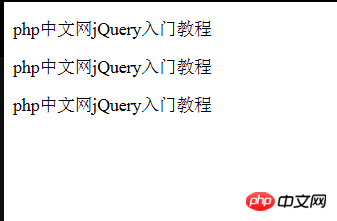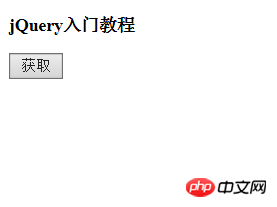 Web Front-end
Web Front-end
 JS Tutorial
JS Tutorial
 How to get the parent element using jquery? jquery method to get parent element
How to get the parent element using jquery? jquery method to get parent element
How to get the parent element using jquery? jquery method to get parent element
In fact, there are many ways to use jquery to get the parent, such as using parent(), parents(), closest(), these can help you find the parent element. Let’s talk about how to use jquery to get the parent. element? jquery method to get parent element.
1. Parent() method
In jQuery, we can use the parent() method to find the "parent element" of the current element. Remember, elements have only one parent.
Syntax: parent(expression)
Description: The parameter expression represents the jQuery selector expression, used to filter parent elements. When the parameter is omitted, all parent elements are selected. If the parameter is not omitted, the parent element that meets the conditions is selected.
Don’t the elements have only one parent element? Why is there still such a thing as "eligible parent element"? For this, take a look at the following example.
Example:
<!DOCTYPE html>
<html xmlns="http://www.w3.org/1999/xhtml">
<head>
<title></title>
<script type="text/javascript" src="../App_js/jquery-1.12.0.min.js"></script>
<script type="text/javascript">
$(function () {
$("p").parent(".lvye").css("color", "red");
})
</script>
</head>
<body>
<div><p>php中文网jQuery入门教程</p></div>
<div class="lvye"><p>php中文网jQuery入门教程</p></div>
<div><p>php中文网jQuery入门教程</p></div>
</body>
</html>The effect is as follows:

## 2. parents() method
The parents() method is similar to the parent() method, both are used to find the ancestor elements of the selected element. But these two methods also have essential differences. In fact, these two methods are also easy to distinguish. parent is in singular form, and there is only one ancestor element to be searched for, which is the parent element. Parents is a plural form, and the ancestor elements to be searched are of course all ancestor elements. Syntax: parents(expression)Description: The parameter expression represents the jQuery selector expression string, used to filter ancestor elements. When the argument is omitted, all ancestor elements are selected. If the parameter is not omitted, the ancestor element that meets the conditions is selected. Example:<!DOCTYPE html>
<html xmlns="http://www.w3.org/1999/xhtml">
<head>
<title></title>
<script type="text/javascript" src="../App_js/jquery-1.12.0.min.js"></script>
<script type="text/javascript">
$(function () {
$("#btn").click(function () {
var parents = $("span").parents()
.map(function () { return this.tagName; })
.get().join(",");
alert("span元素的所有祖先元素为:" + parents.toLowerCase());
});
})
</script>
</head>
<body>
<div><p><strong><span>jQuery入门教程</span></strong></p></div>
<input id="btn" type="button" value="获取" />
</body>
</html>
## The #parentsUntil() method is a supplement to the parents() method. It can find all ancestor elements in the specified range, which is equivalent to intercepting some ancestor elements from the collection returned by the parents() method.
Syntax: parents(expression)Description: The parameter expression represents the jQuery selector expression string, used to filter ancestor elements. When the argument is omitted, all ancestor elements are selected. If the parameter is not omitted, the ancestor element that meets the conditions is selected. The parameter selector represents the jQuery selector expression string, used to determine the ancestor elements of the range. This parameter is optional. If omitted, all ancestor elements will be matched, which is the same as the results of the parents() method. Since the parentsUntil() method is not used much, in order to reduce the memory burden of beginners, we can ignore it directly. If you want to learn more, you can refer to:jQuery Tutorial
.The above is the detailed content of How to get the parent element using jquery? jquery method to get parent element. For more information, please follow other related articles on the PHP Chinese website!

Hot AI Tools

Undresser.AI Undress
AI-powered app for creating realistic nude photos

AI Clothes Remover
Online AI tool for removing clothes from photos.

Undress AI Tool
Undress images for free

Clothoff.io
AI clothes remover

Video Face Swap
Swap faces in any video effortlessly with our completely free AI face swap tool!

Hot Article

Hot Tools

Notepad++7.3.1
Easy-to-use and free code editor

SublimeText3 Chinese version
Chinese version, very easy to use

Zend Studio 13.0.1
Powerful PHP integrated development environment

Dreamweaver CS6
Visual web development tools

SublimeText3 Mac version
God-level code editing software (SublimeText3)

Hot Topics
 1664
1664
 14
14
 1423
1423
 52
52
 1317
1317
 25
25
 1268
1268
 29
29
 1242
1242
 24
24
 Demystifying JavaScript: What It Does and Why It Matters
Apr 09, 2025 am 12:07 AM
Demystifying JavaScript: What It Does and Why It Matters
Apr 09, 2025 am 12:07 AM
JavaScript is the cornerstone of modern web development, and its main functions include event-driven programming, dynamic content generation and asynchronous programming. 1) Event-driven programming allows web pages to change dynamically according to user operations. 2) Dynamic content generation allows page content to be adjusted according to conditions. 3) Asynchronous programming ensures that the user interface is not blocked. JavaScript is widely used in web interaction, single-page application and server-side development, greatly improving the flexibility of user experience and cross-platform development.
 The Evolution of JavaScript: Current Trends and Future Prospects
Apr 10, 2025 am 09:33 AM
The Evolution of JavaScript: Current Trends and Future Prospects
Apr 10, 2025 am 09:33 AM
The latest trends in JavaScript include the rise of TypeScript, the popularity of modern frameworks and libraries, and the application of WebAssembly. Future prospects cover more powerful type systems, the development of server-side JavaScript, the expansion of artificial intelligence and machine learning, and the potential of IoT and edge computing.
 JavaScript Engines: Comparing Implementations
Apr 13, 2025 am 12:05 AM
JavaScript Engines: Comparing Implementations
Apr 13, 2025 am 12:05 AM
Different JavaScript engines have different effects when parsing and executing JavaScript code, because the implementation principles and optimization strategies of each engine differ. 1. Lexical analysis: convert source code into lexical unit. 2. Grammar analysis: Generate an abstract syntax tree. 3. Optimization and compilation: Generate machine code through the JIT compiler. 4. Execute: Run the machine code. V8 engine optimizes through instant compilation and hidden class, SpiderMonkey uses a type inference system, resulting in different performance performance on the same code.
 Python vs. JavaScript: The Learning Curve and Ease of Use
Apr 16, 2025 am 12:12 AM
Python vs. JavaScript: The Learning Curve and Ease of Use
Apr 16, 2025 am 12:12 AM
Python is more suitable for beginners, with a smooth learning curve and concise syntax; JavaScript is suitable for front-end development, with a steep learning curve and flexible syntax. 1. Python syntax is intuitive and suitable for data science and back-end development. 2. JavaScript is flexible and widely used in front-end and server-side programming.
 JavaScript: Exploring the Versatility of a Web Language
Apr 11, 2025 am 12:01 AM
JavaScript: Exploring the Versatility of a Web Language
Apr 11, 2025 am 12:01 AM
JavaScript is the core language of modern web development and is widely used for its diversity and flexibility. 1) Front-end development: build dynamic web pages and single-page applications through DOM operations and modern frameworks (such as React, Vue.js, Angular). 2) Server-side development: Node.js uses a non-blocking I/O model to handle high concurrency and real-time applications. 3) Mobile and desktop application development: cross-platform development is realized through ReactNative and Electron to improve development efficiency.
 How to Build a Multi-Tenant SaaS Application with Next.js (Frontend Integration)
Apr 11, 2025 am 08:22 AM
How to Build a Multi-Tenant SaaS Application with Next.js (Frontend Integration)
Apr 11, 2025 am 08:22 AM
This article demonstrates frontend integration with a backend secured by Permit, building a functional EdTech SaaS application using Next.js. The frontend fetches user permissions to control UI visibility and ensures API requests adhere to role-base
 Building a Multi-Tenant SaaS Application with Next.js (Backend Integration)
Apr 11, 2025 am 08:23 AM
Building a Multi-Tenant SaaS Application with Next.js (Backend Integration)
Apr 11, 2025 am 08:23 AM
I built a functional multi-tenant SaaS application (an EdTech app) with your everyday tech tool and you can do the same. First, what’s a multi-tenant SaaS application? Multi-tenant SaaS applications let you serve multiple customers from a sing
 From C/C to JavaScript: How It All Works
Apr 14, 2025 am 12:05 AM
From C/C to JavaScript: How It All Works
Apr 14, 2025 am 12:05 AM
The shift from C/C to JavaScript requires adapting to dynamic typing, garbage collection and asynchronous programming. 1) C/C is a statically typed language that requires manual memory management, while JavaScript is dynamically typed and garbage collection is automatically processed. 2) C/C needs to be compiled into machine code, while JavaScript is an interpreted language. 3) JavaScript introduces concepts such as closures, prototype chains and Promise, which enhances flexibility and asynchronous programming capabilities.



